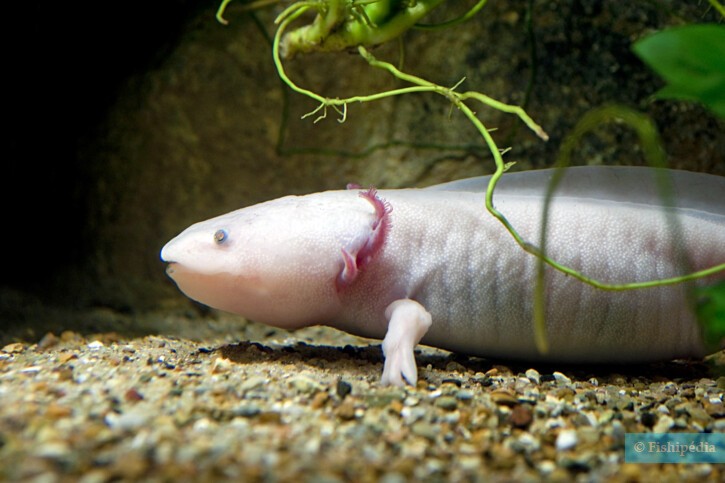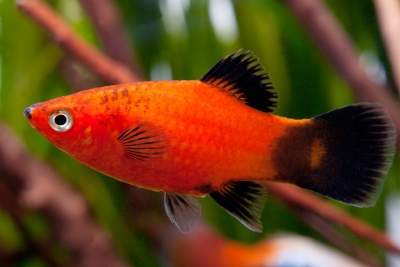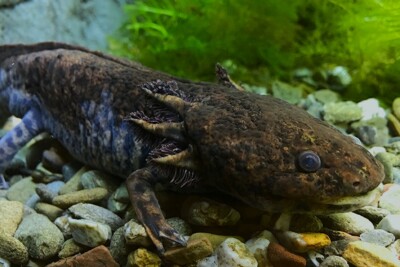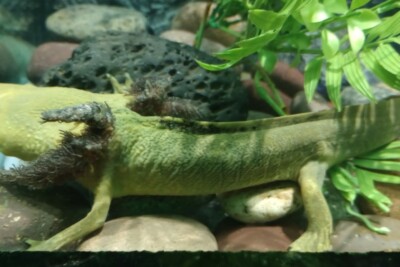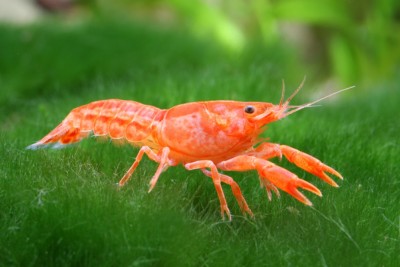axolotl
| Scientific name | Ambystoma mexicanum |
|---|---|
| Descriptor | Shaw & Nodder |
| Year of description | 1798 |
| IUCN category (World) | CR |
| Family | Ambystomatidae |
| Genus | Ambystoma |
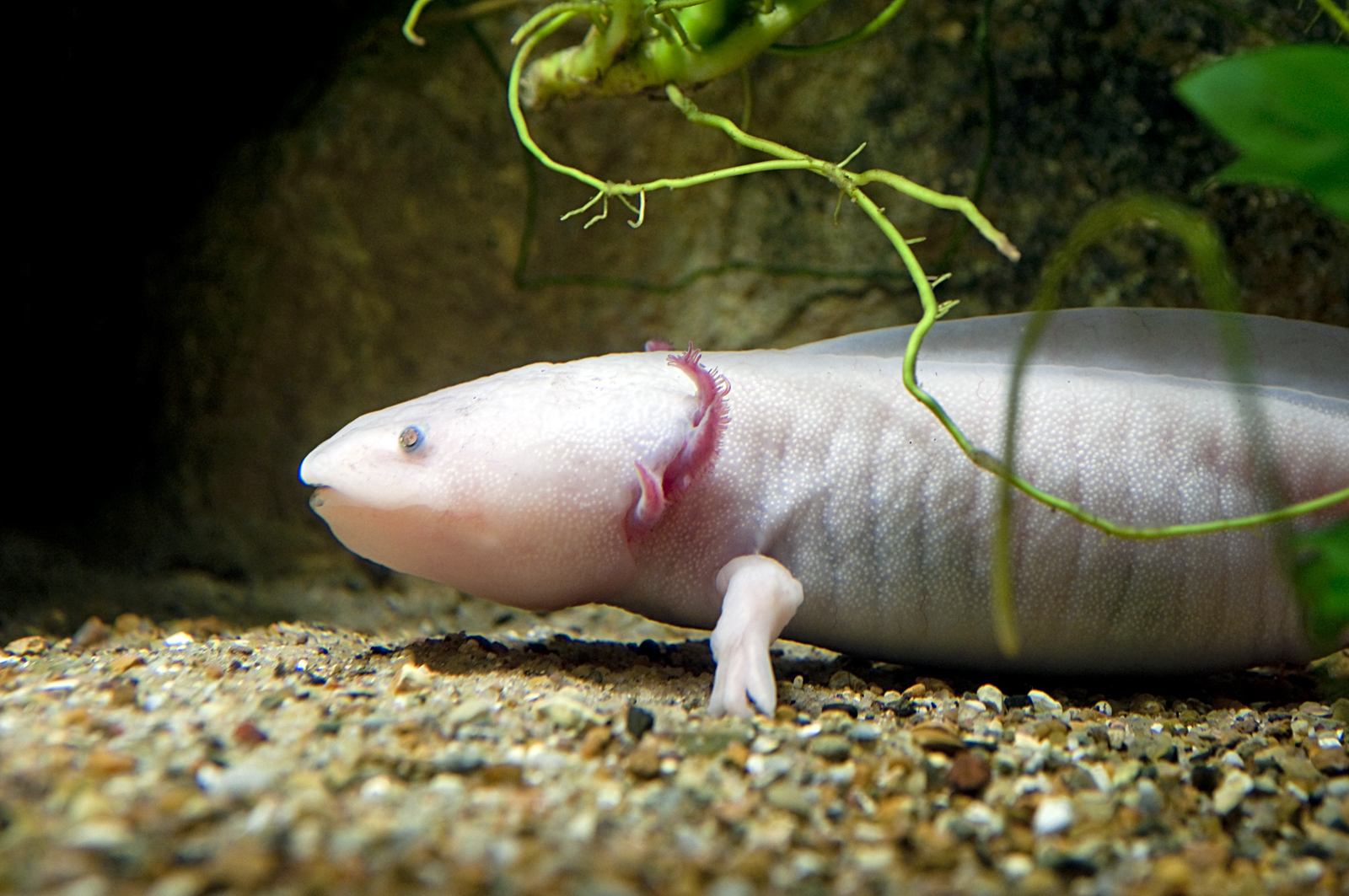

Introduction
Ambystoma mexicanum, commonly known as axolotl, is a fresh water amphibian from the Central America.
This sheet is currently being prepared. The texts currently proposed come from our data model or are being drafted. To request priority for this content, you can write to us HERE.
Who is it?
Morphology
-
Size15 - 33 cm
-
Motifmottling
-
Longevity15 year
-
Size15 - 33 cm
-
Motifmottling
-
Longevity15 year
How to recognize the axolotl ?
The axolotl measures between 15 and 33 cm. this amphibian is unicolore with a predominantly marron, blanc, beige and gris body. The also has marron and beige mottling.
Behaviour & Life cycle
-
Sociabilityliving in a group or alone
-
Way of livingnocturnal
-
VenomousNo
-
Dietpredator
The axolotl is an amphibian living in a group or alone. This species is carnivorous . this amphibian lives mainly at night. Usually, it leaves its hiding place and starts to be active once it gets dark.
Although the axolotl is non-territorial, it is sometimes aggressive towards other species.
Reproduction
-
Reproductionovipare
The axolotl is an amphibian ovipare. this amphibian protects its eggs from nearby predators.
Harmless species
This species does not represent any particular threats to humans when encountered in its natural environment.
Where to find it?
What is its habitat?
Natural environment characteristics
-
Temperature6 - 20 °C
-
FlowStagnant
Biotope presentation
The acidification of water comes from the decomposition of plants. This phenomenon changes the color of the water, which tends to turn brown. In some areas particularly rich in organic matter, the water is so dark that it is called "black water".
The axolotl is most often found at a depth between 0m and 2m. However, it is not impossible to find this species at other depths. This animal evolves in areas characterized by a strong presence of vegetation (aquatic and marsh plants, decaying organic matter, roots...).
This species lives near large roots, in which it can find refuge in case of danger. This type of habitat is often found not far from the banks.
Species of the same biotope
Main recommendations for fishkeeping
Deontology
In order to preserve wildlife, if you acquire this animal, it must not be released into the wild. See also, the Fishipedia charter.
Fishipedia supports the practice of responsible and environmentally friendly aquarium keeping. We encourage maintenance if it is motivated by a desire to understand the biological functioning of living things and if it is done with respect for animal life.
We believe that aquaristics is an opening to the discovery of aquatic environments, especially freshwater, and that this knowledge is necessary to better protect and respect these environments. Logically, we refute the compulsive purchase of animals that would not find a sufficient and / or adapted place in the host aquarium.
Our recommendations
-
Min volume200 liters
-
Population min1
-
Temperature6 - 20 °C
Characteristics
-
Behaviourslightly aggressive
-
Robustness
General reminders
It is strongly advised to read the complete dedicated file and to get information on the feedbacks of maintenance of the envisaged animal, this to avoid any potential conflict whose end result is generally the death of the individual (or the other inhabitants). It is important not to overload your aquarium to limit pollution. This will make maintenance easier.
In nature, animals are subject to weather conditions and live in waters with variable characteristics. The recommendations offered by our team for aquarium maintenance are a guidance and cannot be assimilated to scientific datas.
General reminder on maintenance datas
Le démarrage d'un aquarium est une partie primordiale pour l'équilibre et le bien-être des poissons. Lorsque l'on met en eau un aquarium, l'eau passe naturellement par un cycle biologique : le cycle de l'azote. Celui-ci dure environ trois semaines. Tous les 2 jours, nous vous conseillons de tester votre eau jusqu'à ce que le taux de nitrite soit à zéro pendant plusieurs jours d'affilée.
Pour accélérer ce cycle, vous pouvez utiliser un activateur de bactéries comme JBL Denitrol. Cette solution riche en bactéries vivantes et enzymes permet une mise en place rapide du cycle de l'azote. Les poissons peuvent alors être introduits plus rapidement.
Il est important de tester l'eau de son aquarium régulièrement pour maintenir un environnement sain pour les poissons et les autres habitants. Les tests d'eau permettent de mesurer les niveaux de différents paramètres tels que le pH, la dureté totale, ainsi que les taux de nitrates, de nitrites et d'ammoniaque.
Pour réaliser ces tests, vous pouvez utiliser des produits d'analyse spécialisés tels que JBL ProScan qui permet de réaliser un diagnostic de l'eau directement via un smartphone. Il existe également des coffrets de tests plus classiques de bandelettes, comme JBL PROAQUATEST.
En cas d’usage de l’eau du robinet, vous pouvez utiliser un conditionneur d’eau de type Biotopol de JBL pour éliminer les substances nocives comme le chlore, le cuivre, le plomb et le zinc. Les conditionneurs d'eau garantissent une meilleure santé aux poissons et une meilleure croissance des plantes.
Chlorine and chloramine are dangerous for the health of animals. Used to disinfect water, these agents are present in significant quantities in tap water. We recommend using an anti-chlorine agent every time you change the water. In addition to chlorine, treatments and medicines sold for aquarium use sometimes contain dangerous heavy metals in high doses.
Specific needs for the axolotl
The axolotl is a species which lives naturally at a temperature between 6 °C and 20 °C. For proper maintenance, the temperature should never exceed the 23°C for long periods. Nitrate levels should remain below 50mg/L. To keep the water clean and unpolluted, plan on changing 20% to 30% of the water volume each month.
The breeding of this species is accessible on condition of being well informed about its needs in aquarium . Any cohabitants must be chosen with care to avoid the loss of animals.
This species is generally available in specialized shops or from aquarium clubs. Specimens that have been bred for a long time are easier to breed, but special water parameters must be respected.
Heating not required
As this species is used to living in fairly cool water, the presence of a resistance is not necessary in your aquarium. Also be careful to control the temperature of your tank in summer.Formal incompatibilities
Cohabitation & Environment
The axolotl is an amphibian which it is advisable to maintain in specific aquarium. A 200 liter tank is sufficient to consider its breeding. Associating it with other species is not fundamentally impossible but a documentation work is necessary for the constitution of the population.
The species enjoys a particularly vegetation-rich environment. The addition of plants will provide many useful hiding places for resting. These areas are also conducive to possible breeding in the aquarium.
Acid Water Maintenance
The axolotl living naturally in acidic water, generally in "black" or "sieved" water, the implementation of a filtration on peat is ideal for its balance. Adding decaying leaves and alder fruit can significantly improve living conditions by naturally increasing acidity of some water.Tips for feeding
The axolotl is carnivorous.
This species does not appreciate being fed with freeze-dried food (flakes...). Some specimens will never eat this type of food.
You should not overfeed your residents to avoid polluting the water. For most species, it is better to feed a few small portions each day rather than one large meal.
Reproduction protocol
-
Maintenance difficultyhard
-
Spawning cleaningNo
-
egg-laying protectionNo
-
Fry protectionNo
Hybridization risks
In general, it is advised not to mix several species of the same genus or different varieties of the same species, to avoid the risks of hybridization.
To go further
Sources & Contributions
Participation & Validation
The Fishipedia team and specialist contributors are committed to providing high-quality content. However, although the information comes from scientific sources or testimonials from specialists, the cards may contain inaccuracies.

Adrien Falzon
Translation
Translation done with the valuable contribution of our translators, who make this information available to a wider audience. We sincerely thank them for their commitment.
Scientific partners
Same genus
Species of the same biotope
